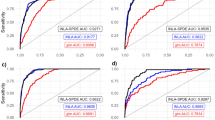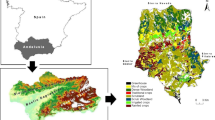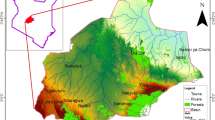Abstract
Modeling plant habitat range distributions is critical for monitoring and restoring species in their natural habitat. The classical logistic regression (LR) model for plant habitat distribution has several drawbacks such as neglecting the effects of the important variables and sensitivity to non-correlation variables. In this paper, an autoregressive logistic regression (ALR)-based conjugate gradient training approach was proposed to improve the drawbacks of LR in predicting the presence and absence of spatial habitat distribution based on input attributes including soil gypsum amount (gyps), lime content, soil available moisture (AM), soil electrical conductivity (EC), clay, and gravel amounts in Poshtkouh rangelands of Yazd Province, Iran. The conjugate gradient approach to calibrate logit model is extended by an iterative formulation using a limited scalar factor and adaptive step size. The predicted results of the classical LR and ALR were validated for nine plant habitats based on several comparative error statistics. The results illustrated that different coefficients were obtained for LR and ALR models but the proposed ALR performed better than the LR in estimating the occurrence probability of plant species.



Similar content being viewed by others
References
Abd El-Ghani MM, Amer WM (2003) Soil-vegetation relationships in a coastal desert plain of southern Sinai Egypt. J Arid Environ 55:607–628. https://doi.org/10.1016/S0140-1963(02)00318-X
Allen SE (1974) Chemical analysis of ecological material. Blackwell, Hoboken
Araújo MB, New M (2007) Ensemble forecasting of species distributions. Trends Ecol Evol 22(1):42–47. https://doi.org/10.1016/j.tree.2006.09.010
Ardestani EG, Tarkesh M, Bassiri M, Vahabi MR (2015) Potential habitat modeling for reintroduction of three native plant species in central Iran. J Arid Land 7(3):381–390
Augustin NH, Mugglestone MA, Buckland ST (1996) An autologistic model for the spatial distribution of wildlife. J Appl Ecol 33(2):339–347
Bo YC, Song C, Wang JF, Li XW (2014) Using an autologistic regression model to identify spatial risk factors and spatial risk patterns of hand, foot and mouth disease (HFMD) in Mainland China. BMC Public Health 14(1):358
Chen G, Tu L, Chen G, Hu J, Han Z (2018) Effect of six years of nitrogen additions on soil chemistry in a subtropical Pleioblastus amarus forest Southwest China. J For Res 29(6):1657–1664
Diop L, Bodian A, Djaman K, Yaseen ZM, Deo RC, El-shafie A, Brown LC (2018) The influence of climatic inputs on stream-flow pattern forecasting: case study of Upper Senegal River. Environ Earth Sci 77:182. https://doi.org/10.1007/s12665-018-7376-8
Dubuis A, Pottier J, Rion V (2011) Predicting spatial patterns of plant species richness: a comparison of direct macro ecological and species stacking modeling approaches. Divers Distrib 17:1122–1131. https://doi.org/10.1111/j.1472-4642.2011.00792.x
Elith J, Graham C (2009) Do they? How do they? Why do they differ? On finding reasons for differing performances of species distribution models. Ecography 32:66–77
Elzwayie A, El-shafie A, Yaseen ZM, Afan HA, Allawi MF (2016) RBFNN-based model for heavy metal prediction for different climatic and pollution conditions. Neural Comput Appl. https://doi.org/10.1007/s00521-015-2174-7
Franklin J, Davis FW, Ikegami M, Syphard AD, Flint LE, Flint AL, Hannah L (2013) Modeling plant species distributions under future climates: how fine scale do climate projections need to be? Glob Change Biol 19:473–483. https://doi.org/10.1111/gcb.12051
Graham CH, Hijmans RJ (2006) A comparison of methods for mapping species ranges and species richness. Glob Ecol Biogeogr 15:578–587. https://doi.org/10.1111/j.1466-8238.2006.00257.x
Guisan A, Weiss SB, Weiss AD (1999) GLM versus CCA spatial modeling of plant species distribution. Plant Ecol 143:107–122
Guisan A, Edwards T.C., Hastie, T., (2002) Generalized linear and generalized additive models in studies of species distributions: setting the scene. Ecol Model 157:89–100. https://doi.org/10.1016/S0304-3800(02)00204-1
Guisan A, Graham CH, Elith J, Huettmann F (2007) Sensitivity of predictive species distribution models to change in grain size. Divers Distrib 13:332–340
Hernandez PA, Franke I, Herzog SK, Pacheco V, Paniagua L, Quintana HL, Soto A, Swenson JJ, Tovar C, Valqui TH (2008) Predicting species distributions in poorly-studied landscapes. Biodivers Conserv 17:1353–1366
Hosmer DW, Lemeshow S (2000) Applied logistic regression. Wiley, Hoboken
Hosseini SZ, Kappas M, Zare Chahouki MA, Gerold G, Erasmi S, Rafiei Emam A (2013) Modeling potential habitats for Artemisia sieberi and Artemisia aucheri in Poshtkouh area, central Iran using the maximum entropy model and geostatistics. Ecol Inform 18:61–68. https://doi.org/10.1016/j.ecoinf.2013.05.002
Ji X, Chen L, Zhang A (2017) Anchorage properties at the interface between soil and roots with branches. J For Res 28(1):83–93
Jones-Farrand DT, Fearer TM, Thogmartin WE, Iii FRT, Nelson MD, Tirpak JM (2011) Comparison of statistical and theoretical habitat models for conservation planning: the benefit of ensemble prediction. Ecol Appl 21:2269–2282
Keshtegar B, Piri J, Kisi O (2016a) A nonlinear mathematical modeling of daily pan evaporation based on conjugate gradient method. Comput Electron Agric 127:120–130
Keshtegar B, Allawi MF, Afan HA, El-Shafie A (2016b) Optimized river stream-flow forecasting model utilizing high-order response surface method. Water Resour Manage 30:3899–3914. https://doi.org/10.1007/s11269-016-1397-4
Keshtegar B, Hasanipanah M, Bakhshayeshi I, Sarafraz ME (2019) A novel nonlinear modeling for the prediction of blast-induced airblast using a modified conjugate FR method. Measurement 131:35–41
Khalasi Ahvazi L, Zare Chahouki MA, Ghorbannezhad F (2012) Comparing discriminant analysis, ecological niche factor analysis and logistic regression methods for geographic distribution modeling of Eurotia ceratoides (L.) C A. Mey. Rangel Sci 3:45–57
Kikvidze Z, Pugnaire FI, Brooker RW et al (2005) Linking patterns and processes in alpine plant communities: a global study. Ecology 86:1395–1400. https://doi.org/10.1890/04-1926
Kowsar R, Keshtegar B, Marey MA, Miyamoto A (2017) An autoregressive logistic model to predict the reciprocal effects of oviductal fluid components on in vitro spermophagy by neutrophils in cattle. Sci Rep. https://doi.org/10.1038/s41598-017-04841-z
Liu C, Berry PM, Dawson TP, Pearson RG (2005) Selecting thresholds of occurrence in the prediction of species distributions. Ecography 28:385–393
Luoto M, Hjort J (2005) Downscaling of coarse-grained geomorphological data. Earth Surf Process Landf 33:75–89
Maalouf M, Trafalis TB (2011) Robust weighted kernel logistic regression in imbalanced and rare events data. Comput Stat Data Anal 55:168–183. https://doi.org/10.1016/j.csda.2010.06.014
Manel S, Dias JM, Buckton ST, Ormerod SJ (1999) Alternative methods for predicting species distribution: an illustration with Himalayan river birds. J Appl Ecol 36:734–747
Marmion M, Parviainen M, Luoto M, Heikkinen RK, Thuiller W (2009) Evaluation of consensus methods in predictive species distribution modeling. Divers Distrib 15:59–69
McCune B (2006) Non-parametric habitat models with automatic interactions. J Veg Sci 17:819–830
Miller J, Franklin J (2002) Modeling the distribution of four vegetation alliances using generalized linear models and classification trees with spatial dependence. Ecol Model 157:227–247
Phillips SJ, R.P. Anderson., Schapire, R.E., (2006) Maximum entropy modeling of species geographic distributions. Ecol Model 190:231–259
Piri Sahragard H, Ajorlo M (2017) A comparison of logistic regression and maximum entropy for distribution modeling of range plant species (A case study in rangelands of Western Taftan, Southeastern Iran). Turk J Bot 42:28–37. https://doi.org/10.3906/bot-1612-5
Piri Sahragard H, Zare Chahouki MA (2015) An evaluation of predictive habitat models performance of plant species in Hoze soltan rangelands of Qom province. Ecol Model 309–310:64–71. https://doi.org/10.1016/j.ecolmodel.2015.04.005
Piri Sahragard H, Ajorlo M, Karami P (2018) Modeling habitat suitability of range plant species using random forest method in arid mountainous rangelands. J Mt Sci 15(10):1–13. https://doi.org/10.1007/s11629-018-4898-1
Pottier J, Dubuis A, Pellissier L et al (2013) The accuracy of plant assemblage prediction from species distribution models varies along environmental gradients. Glob Ecol Biogeogr 22:52–63. https://doi.org/10.1111/j.1466-8238.2012.00790.x
Saupe EE, Barve V, Myers CE, Soberón J, Barve N, Hensz CM, Peterson AT, Owens HL, Lira-Noriega A (2012) Variation in niche and distribution model performance: The need for a priori assessment of key causal factors. Ecol Model 237–238:11–22. https://doi.org/10.1016/j.ecolmodel.2012.04.001
Segurado P, Araújo M (2004) An evaluation of methods for modeling species distributions. J Biogeogr 31:1555–1569
Shabani F, Kumar L, Ahmadi M (2016) A comparison of absolute performance of different correlative and mechanistic species distribution models in an independent area. Ecol Evol 6:5973–5986. https://doi.org/10.1002/ece3.2332
Tan CO, Özesmi U, Beklioglu M, Per E, Kurt B (2006) Predictive models in ecology: comparison of performances and assessment of applicability. Ecol Inform 1:195–211. https://doi.org/10.1016/j.ecoinf.2006.03.002
Tarkesh M, Jetschke G (2012) Comparison of six correlative models in predictive vegetation mapping on a local scale. Environ Ecol Stat 19:437–457. https://doi.org/10.1007/s10651-012-0194-3
Thomas CD, Cameron A, Green RE, Bakkenes M, Beaumont LJ, Collingham YC, Erasmus BFN, Ferreira De Siqueira M, Grainger A, Hannah L, Hughes L, Huntley B, Van Jaarsveld AS, Midgley GF, Miles L, Ortega-Huerta MA, Peterson AT, Phillips OL, Williams SE (2004) Extinction risk from climate change. Nature 427:145–148. https://doi.org/10.1038/nature02121
Wang HH, Wonkka CL, Treglia ML, Grant WE, Smeins FE, Rogers WE (2015) Species distribution modeling for conservation of an endangered endemic orchid. AoB Plants. https://doi.org/10.1093/aobpla/plv039
Wilson DJ, Western AW, Grayson RB (2004) Identifying and quantifying sources of variability in temporal and spatial soil moisture observations. Water Resour Res. https://doi.org/10.1029/2003WR002306
Wisz MS, Hijmans RJ, Li J, Peterson AT, Graham CH, Guisan A (2008) Effects of sample size on the performance of species distribution models. Divers Distrib 14:763–773
Wu H, Huffer FRW (1997) Modeling the distribution of plant species using the autologistic regression model. Environ Ecol Stat 4(1):31–48
Yang XQ, Kushwaha SPS, Saran S (2013) Maxent modeling for predicting the potential distribution of medicinal plant, Justicia adhatoda L. in Lesser Himalayan foothills. Ecol Eng. 51:83–87
Zare Chahouki MA, Piri Sahragard H (2016) Maxent modeling for distribution of plant species habitats of rangelands (Iran). Pol J Ecol 64(4):453–467. https://doi.org/10.3161/15052249PJE2016.64.4.002
Zare Chahouki MA, Azarnivand H, Jafari M, Tavili A (2010) Multivariate statistical methods as a tool for model-based prediction of vegetation types. Russ J Ecol 41:84–94. https://doi.org/10.1134/S1067413610010169
Zare Chahouki MA, Khalasi Ahvazi L, Azarnivand H (2012) Comparison of three modeling approaches for predicting plant species distribution in mountainous scrub vegetation (Semnan rangelands, Iran). Pol J Ecol 60(2):277–289
Author information
Authors and Affiliations
Corresponding author
Additional information
Communicated by Joseph Paul Messina.
Rights and permissions
About this article
Cite this article
Sahragard, H.P., Keshtegar, B., Chahouki, M.A.Z. et al. Modeling spatial distribution of plant species using autoregressive logistic regression method-based conjugate search direction. Plant Ecol 220, 267–278 (2019). https://doi.org/10.1007/s11258-019-00911-6
Received:
Accepted:
Published:
Issue Date:
DOI: https://doi.org/10.1007/s11258-019-00911-6




